
THE SUNPAK DX SERIES OF FLASH UNITS |
|
|
 |
|
|
Sunpak flash units of the DX series were made during the latter part of the film era, from the mid 1980s until at least 2005. Most have “DX” as part of their name and employ a plug-in module that provides the unit with its hot shoe foot. Cameras of that era were acquiring features such as indications of the flash status in the viewfinder, which required communication between the camera and the flash unit. Because there was no standardisation of these auxiliary signals, for the DX series Sunpak offered a different module for each camera brand (or even model) to provide the same features as the camera makers' own flash units.
The DX units were of high quality, and the more powerful ones were aimed at the professional market in which they were the main rivals to Metz and Vivitar as independent makers at that time. These often exceeded the camera makers’ own branded units in both quality and features, while at the same time usually costing less. It is believed that some camera branded units were in fact made by Sunpak under contract. All the DX units I have tested are safe to use on modern cameras with the correct module as long as the camera hot-shoe contact layout has not changed since their time. The Guide Numbers quoted in this article are in metres at ISO 100, with the unit set at the beam angle for a standard lens : ie a 50mm lens in the case of 35mm or Full Frame format. That was the older convention. The marketing of modern flash units usually quotes a Guide Number with the unit set at it maximum zoom, which sounds better but cannot be directly compared with the older convention. SOME CONTEXT [scroll straight down to the DX units if you want] The DX series belonged to the transitional period in flash unit design in that most of them have all three of the then basic modes of exposure control – Manual, Auto, and TTL.
The earliest electronic flash units had only Manual control, in which the photographer set the camera lens aperture to a value according to the Flash Formula. The Flash Formula relates aperture, film speed and subject distance; you can work it out yourself (it is not hard) but you were usually helped by some sort of slide rule or an engraved table on the unit. From about the mid 1970s Auto mode was added, in which the exposure was controlled by a photocell on the flash unit which quenched the flash when enough exposure had been reached. Neither Manual nor Auto modes require direct communication between flash unit and camera. However, camera makers were introducing subsiduary features such as “Flash Ready” indications in the viewfinder, which did require communication.
Then from about 1980 the more advanced cameras introduced TTL (Through The Lens) control of flash, which used a photocell somewhere behind the camera lens to control the flash unit. As implemented in the film era, this was the best method of controlling flash exposure, ever. But at the time there were still plenty of cameras around without TTL capability, so all the DX units except the DX R12 were provided with all three methods of control.
From about 1990 however, flash unit makers began to omit the Auto modes (the Sunpak DX-R12 being an example) in the expectation that all new cameras would be TTL capable. This has unfortunate consequences today, because the technology of TTL control with film cannot be used with digital cameras, and current (c2020) digital cameras use a different, incompatible, and somewhat inferior TTL method. But the Sunpak DX units are still satisfactory on modern digital cameras in their Manual and Auto modes, and in some ways the old Auto mode is superior to the TTL of the digital type. Sunpak also made some non-dedicated flash units at the same time as the DX series. For example the Sunpak 383 was the non-dedicated equivalent of the 36DX and cost less. The flash trigger was the only connection with the camera in these units.
|

| 
|
|---|
| The Auto 24DX has a Guide Number of 24 metres and is a basic unit with an output on the low side of medium and a fixed head. It has three Auto modes, two manual modes (full power and 1/8 power), and a film era TTL mode. |
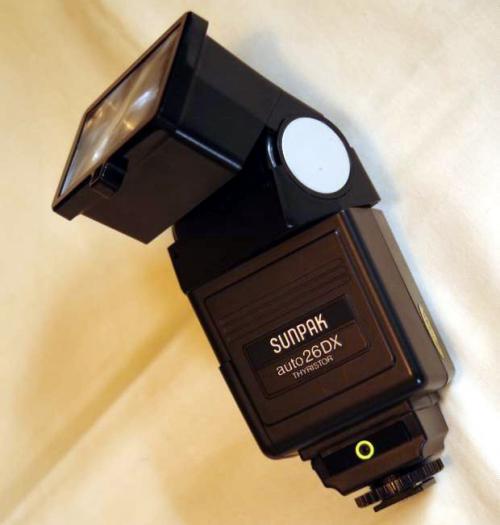
| 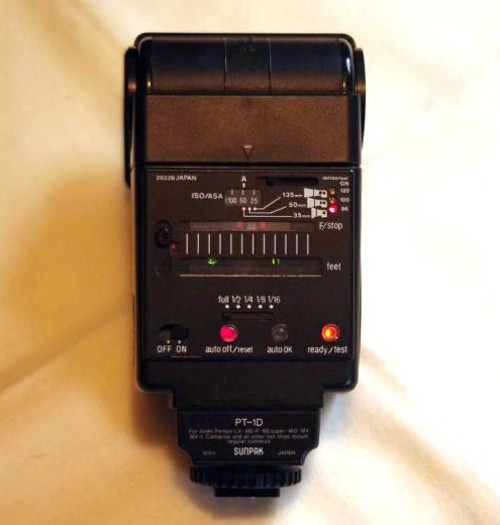
|
|---|
| The Auto 26DX has a Guide Number of 26 metres and is a mid-power unit with a head that can tilt, swivel and zoom. It has three Auto modes, five manual modes, and a film era TTL mode. Alone in this series, it had miniature LEDs on the control panel to indicate the useable subject ranges in the auto modes, depending on the zoom setting of its head; however these seem to be unreliable so it might be a model to avoid. |

| 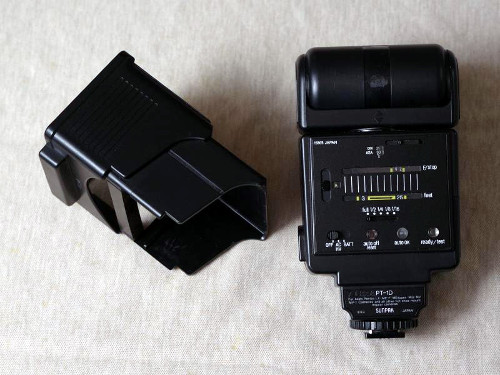
|
|---|
| The Auto 30DX has a Guide Number of 30 metres and is a mid-power unit. The head can tilt and swivel, and there is an optional zoom attachment designated TL-6. It has three Auto modes, five manual modes, and a film era TTL mode. It has a flip-up silver reflector on the head to provide a catchlight if the head is tilted up, as seen in the title picture of this article. |
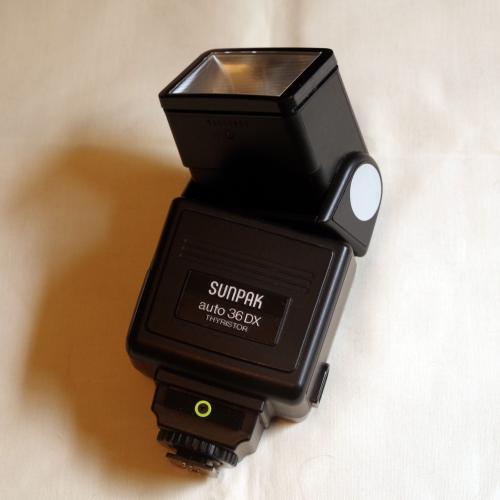
| 
|
|---|
| The Auto 36DX has a Guide Number of 36 metres and is a unit at the high end of mid-power, and about as large and heavy as can be safely used on a camera hotshoe. The head can tilt, swivel and zoom. The detachable zoom head, designated TL-8, seems to have been provided as standard. It has three Auto modes, five manual modes, and a film era TTL mode. Like the 30DX, it has a flip-up silver reflector on the head to provide a catchlight if the head is tilted up. |

| 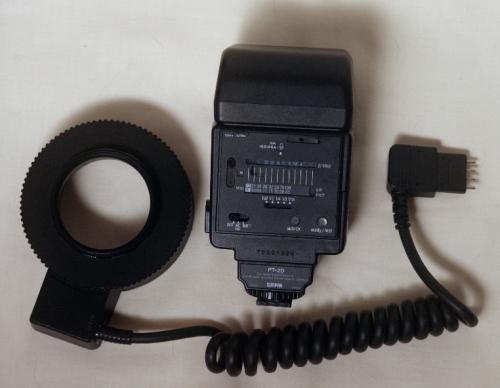
|
|---|
|
The Auto DX 8R is a ring flash with a Guide Number of 8 metres. It has one Auto mode, five manual modes, and a film era TTL mode. The Auto mode might not be satisfactory for very close work because the sensor on the camera hot shoe is out of line with the lens axis. The maximum range in the Auto mode is 1 metre. The flash head attaches to the camera lens by a 52mm filter thread, which may need adapter rings; this throat diameter is rather small for many modern lenses.
In 2001 it was on sale for £190, plus about £50 for the module. |
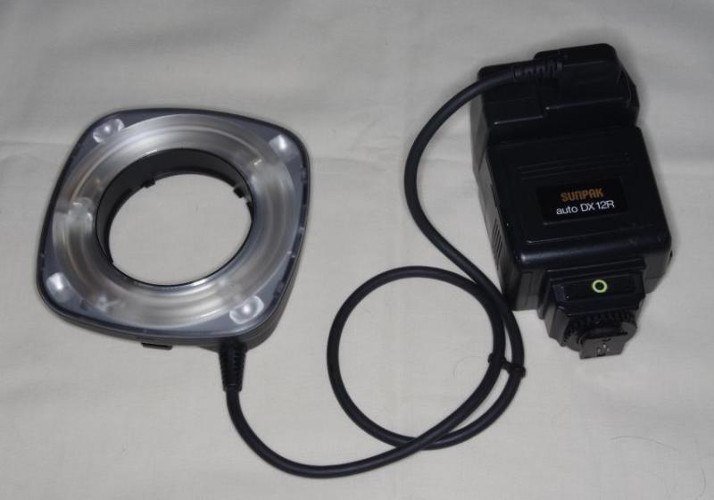
| 
|
|---|
|
The Auto DX 12R is a ring flash with a Guide Number of 12 metres. It has five manual modes and a film era TTL mode. There is no Auto mode, and this is the only one of the DX series not to include it. It thus seems to have been a later introduction to the series, when flash unit makers were omitting the Auto mode.
The flash ring clips to an adaptor which in turn is screwed to the camera lens filter threads. Two adaptors are supplied, for 62mm and 67mm threads, and for other lens threads adaptor rings can be used. It has a significantly wider throat than that of the DX 8R, so is more suitable for modern lenses and film era medium format lenses. There are four LED modelling lights. In 2001 it was on sale for £218, plus about £50 for the module. |
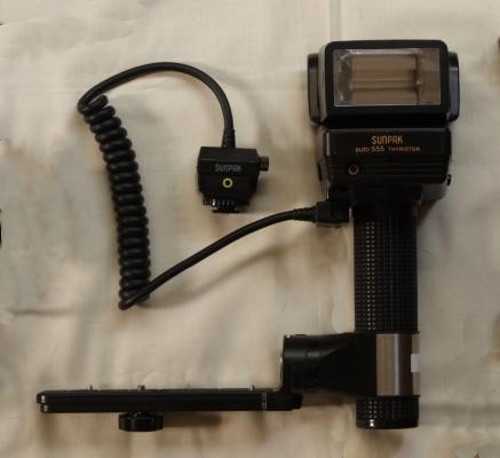
| 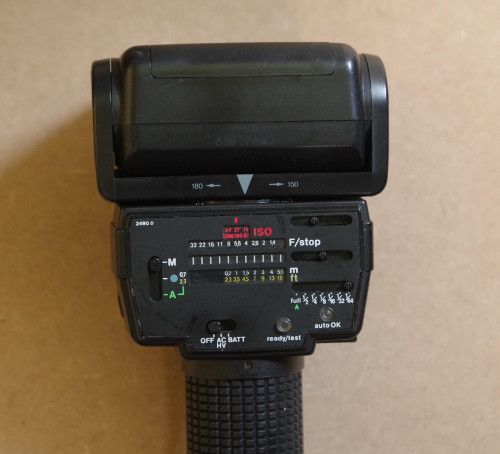
|
|---|
|
The G4500DX (or Auto 555 in some markets) has a Guide Number of 45 metres and is a high power hammerhead unit. The head can tilt and swivel, and can use telephoto and wide angle adaptors. It has seven Auto modes, seven manual modes, and a film era TTL mode. It can use a multi-pin sync cable (designated EXT-11) to connect it to a module in the camera hot-shoe, or alternatively it can use a simple (but still Sunpak proprietary) sync lead without a module and therefore without the dedication features or TTL mode.
The unit has a photocell in the head which controls the exposure for the Auto modes when a simple sync lead is being used. However, when the multi-pin sync lead and module are used, the photocell in the module takes over so that the control is from the camera's position. It is shown here with the Sunpak camera bracket and clamp (which has a quick release), with which it should always be provided. There is an alternative wider bracket for medium format cameras. There is also a non-DX version of this unit, the G4500 or Auto 455, with which it is sometimes confused. That version has only one manual mode (full discharge) and lacks the TTL capability. In 2001 it was on sale for £145, plus sync lead and module. |
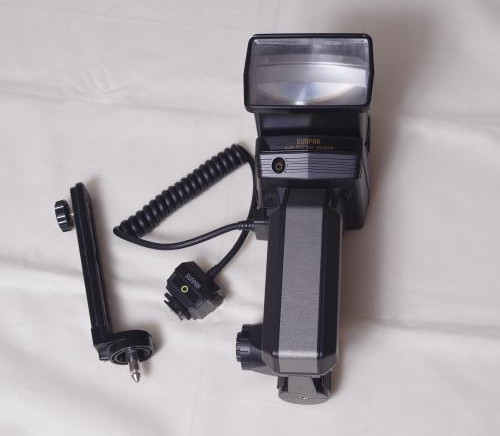
| 
|
|---|
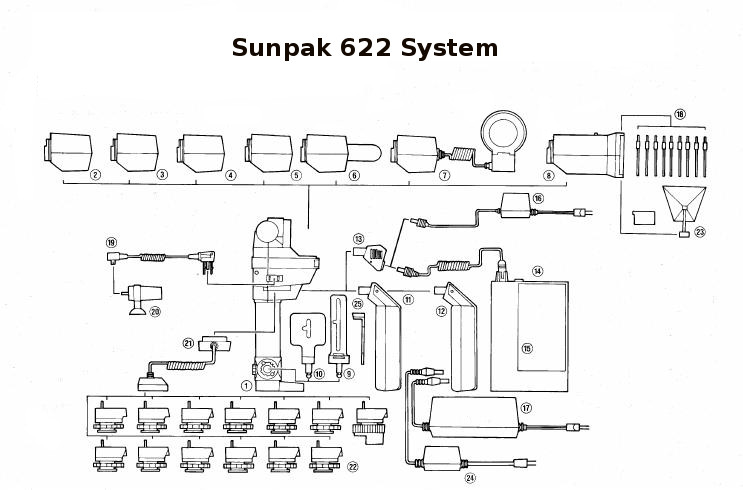
|
|---|
|
The Auto 622 is a powerful "system" hammerhead which, although it does not have "DX" in the name, belongs to the same generation as the other DXes and can use the same camera dedication modules. There are two versions, the "Pro System" and the "Super Pro System" which have Guide Numbers of 50 and 60 metres respectively. They look almost identical, except that the "Pro System" has those words on the front of the head, while the "Super Pro System" has only the word "Sunpak". The two are often confused. The 622 Super Pro System is one of the most powerful portable electronic flash units ever made. They are system flash units. There is a range of eight exchangeable heads including ones for different beam angles, infra-red, bare bulb and ring, which plug into a turret which can tilt and swivel. The battery is in a detachable pod like a handle guard and there are several alternative chargers and power supplies. They use the same camera brackets as the G4500DX and other Sunpak hammerheads of the period. It has seven Auto modes, eight manual modes, and a film era TTL mode. Like the smaller G4500DX, it has a photocell in the head which controls the exposure for the Auto modes when a simple sync lead is being used, but when the multi-pin EXT-11 sync lead and module are used the photocell in the module takes over the control. In 2001 it was on sale for £275, plus sync lead and module. |

| 
|
|---|
|
The 120J is a bare-bulb unit with a detachable parabolic reflector. Although it does not have "DX" in the name, some versions of it do use the DX modules while other versions have a fixed foot. Its Guide Number depends on the reflector configuration, and with it removed it is much more influenced by the surroundings than a conventional unit. The manual states it is 45 metres with the reflector at the standard position and 36 metres at the wide angle position. The slide rule on the back impies a Guide Number of 48 metres.
Apart from the slide rule values, the body appears to be identical with that of the 36DX. It has three Auto modes, five manual modes, and a film era TTL mode. |
ACCESSORIES | |
|
The essential accessory for a DX unit is a module to suit the camera it is to be used on. These plug into the underside of the flash unit body, or into one end of the EXT-11 sync lead used with the G4500DX and 622. The connection is by a circuit card edge connector and these are are not designed for repeated insertions, so it seems Sunpak expected the modules to be fitted semi-permanently. I think that is reasonable.
As time went on, some modules for particular camera brands were produced in later versions to keep up with additional camera functions or other changes. For example the CA-2D for earlier Canon SLRs was supplemented by the CA-3D for the EOS cameras. There is a table below of the modules available towards the end of the DX period. It includes a STD-1D which has only the single centre contact for the flash trigger signal, and will work on any camera with the corresponding contact in its hot shoe - which is almost every camera except certain Minolta/Konica/Sony and Canon models, but without dedication features of course. These modules cost around £20 in the late 1980s, rising to over £50 in 2005. When new, the STD-1D was cheaper than the camera dedicated ones, although in the used market today it fetches a higher price, presumably because of its universality. |
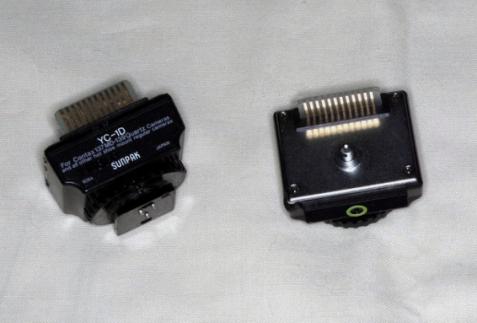
| 
|
|---|
|
There are some special sync cords associated with the DX series. One, designated EXT-11, is a multi-pin cord for connecting the G4500DX/555 and 622 hammerhead units to a module on the camera hot-shoe, and it carries the dedication functions. Others are to enable a hot-shoe unit (ie non-hammerhead) to be placed away from the camera, possibly hand-held or on a bracket as an improvised hammerhead. In earlier years there were at least three different types of these (EXT-06, EXT-07 and EXT-08) for different camera brands, but later this distilled into an EXT-09 for Canon and EXT-10 for everything else. The pictiure below shows an EXT-10 and an EXT-11. |

|
|---|
|
There is a variety of power supplies. All the units can take AA batteries except the 622 which can take size C batteries. The two hammerhead units hold their batteries in pods, so that one with exhausted batteries can be quickly exchanged for one with fresh batteries. Sunpak also sold alternative NiCad rechargeable pods, but being 20-30 years old these might not be able to hold their charge well today. All the units except the 24DX and 26DX can also accept an external power supply, either from a mains adaptor or from a 510 volt battery pack. The mains adaptor recommended for the G4500DX and 622 hammerheads is the AD26, and for the others it is the AD27 pictured below. The two mains adaptors have different sized plugs for the flash unit body; despite this the same 510 volt battery pack is used for all the units and because of the different plug sizes a small adaptor is required to connect the battery pack lead to the non-hammerhead units. That is shown in the smaller picture below. The picture at the bottom below shows two battery pods for a G4500DX, each of which hold six AA batteries. |

| 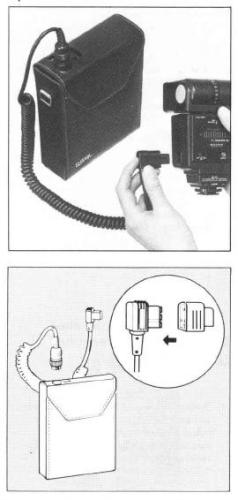
|
|---|
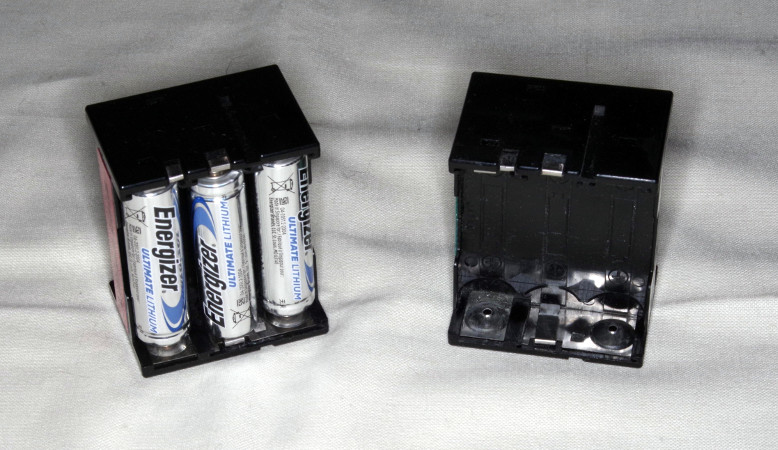
|
|---|
USING DX SERIES FLASH UNITS TODAY |

|
|---|
|
The main potential problem with using older flash units is that most of those designed before about 1980 had high trigger voltages. This is the voltage on the central contact in the hot-shoe, and could reach values as high as 300v which is enough to damage the electronics inside many cameras made after that date. Earlier cameras used a mechanical microswitch to complete the flash trigger circuit and were not affected by the high voltage. This is not only an issue for digital cameras as is often assumed, but also for the later film cameras. However, the Sunpak DX series originated in the latter end of the film era and were designed with low trigger voltages. I have not found one with a voltage of more than 15 volts, and there is now a standard that cameras should be capable of dealing with up to 24 volts. There is a report of Canon recommending no more than 6 volts for one of their cameras, but otherwise it is generally true that the Sunpak DX series are safe with modern cameras as far as trigger voltage is concerned. The contact layout in the hot-shoe also needs to be considered. The DX Series use camera brand specific modules that matched the unit to the contact layout prevalent at the time. Unfortunately some camera makers have since changed their layout, particularly Canon and Minolta/Konica/Sony which have a track record of such changes, so the user should check before buying any older flash unit for one of those cameras. The addition of further contacts in camera hot shoes (the count keeps rising) does not matter so much as they will not be transmitted to the flash unit (as long as no inadvertant contacts are made) and are generally for auxiliary functions that a DX unit will not have anyway. It has been mentioned that modern digital cameras use a different TTL flash control technology from that used in the film era. Therefore the film-oriented TTL mode which all DX units have is of no use with them. Nevertheless, the Manual and Auto modes can be used (except the DX-R12 ring flash lacks Auto), and there is an opinion that the Auto mode is superior to digital TTL anyway (although film era TTL, when usable, was superior to both). Digital TTL involves sending out a low level pre-flash, which can disturb wildlife subjects for example. The disadvantage of Auto mode is that the user does not have a completely free choice of lens aperture, although the top end DX units offer a large range of them, especially when combined with the ability to change the ISO on the camera. The Manual mode of a flash unit gives the greatest freedom at the expense of more involvement of the user with the settings. Another problem with any film era flash unit is that the range of ISO sensitivity offered in the settings is low compared with the capabilities of digital cameras. Typically, ISO 1600 will be the maximum, corresponding to the capability of normal films. Again, this limitation can be overcome in the Auto modes by some minor mental arithmetic (reducing the aperture below the recommended to compensate for a higher sensitivity) or by resorting to the Manual mode and using the Flash Formula in its entirety. Many users do not realise that the Manual mode slider or dial on flash units is not generally connected to anything inside – it is just a slide rule to evaluate the Flash Formula, so you are not restricted to its range in any way. As a last resort with digital cameras, you can find the right exposure by trial and error, viewing the resulting picture on the display. Trial and error is a time-honoured method in studios, which in film days often used Polaroid shots to check lighting levels before starting a shoot. Most flashgun designed in the film era were not designed with rechargeable batteries in mind. Carbon-zinc or alkaline batteries were the norm. Neither type is rechargeable and they both produce about 1.5 volts, although alkalines are preferable in every respect. Alkalines do cost more but last disproportionately longer. These units do of course lack some of the features of modern units, such as HSS (High Speed Sync) and built-in radio transmission to slave units, automatic co-ordination of motorised zoom levels to match the camera, touch screens, and digital-era TTL control. It may be found that not all of the camera viewfinder signals, such as exposure confirmation, work as they did with the film cameras of their own time. Nevertheless, these flash units are satisfactory for the vast majority of normal uses, and were well regarded as such in their day. Because many users of modern digital cameras assume that flash units from the film era, even the more recent ones, are not useable on their cameras, the units of the Sunpak DX Series (and of other brands of this period) can now be found at bargain prices in the used market. |
Trigger Voltages |
|
The wider issue of trigger voltages is covered in this article. The trigger voltages of the DX units that I have measured are all below about 15 volts, which is significantly less than the modern recommendation that cameras should be able to tolerate at least 24 volts. However, there is a report that Canon recommend no more than 6 volts on at least one of their digital cameras.
The DX voltages vary depending on the module fitted, and the table in the appendix below covers all the combinations that I have tested. I do not have a copy of every module, and I do not have a 120J body, although the 120J body looks almost identical to that of the 36DX. The "Standard" STD-1D module has no internal electronics and passes the trigger voltage straight through to its single foot contact. Therefore the STD-1D module voltages in the first row of the table are the "natural" voltages of the various bodies. From this it appears that the 26DX has an exceptionally low voltage among the hotshoe units, and the hammerheads and ring flash units are also lower. The 36DX has a slightly higher natural voltage. While I have not tested all modules, it is highly unlikely that any of them would increase the trigger voltage from the body's natural level. It is also noticable that the Pentax PT-1D and PT-2D modules pass a significantly lower voltage through to the foot than the other modules; Pentax's own flashguns of this period had trigger voltages of around 9 volts. |
AppendixTable of Trigger Voltages |
|
This table shows the trigger voltage with all combinations of flashgun body and module which I have measured.
|
| Model :- | 24DX | 26DX | 30DX | 36DX | DX 8R | DX 12R | G4500DX | 622 | 120J |
| STD-1D (ISO 518) |
11.4v | 5.3v | 11.4v | 15.0v | 6.9v | 7.0v | 6.8v | 7.4v | |
| BR-1D Bronica |
|||||||||
| CA-3D (Earlier Canon) |
|||||||||
| CA-3D (Later Canon) |
|||||||||
| HA-2D (Hasselblad) |
|||||||||
| KX-1D (Konica) |
|||||||||
| MX-1D (Minolta 2 Contacts) |
|||||||||
| MX-2D (Minolta 3 Contacts) |
|||||||||
| MX-1AF (Minolta/Sony iISO) |
|||||||||
| NE-1D (Nikon FE,EM) |
|||||||||
| NE-2D (Nikon) |
11.4v | 5.3v | 11.4v | 11.4v | 6.9v | 7.0v | 6.8v | 7.4v | |
| NE-3D (Nikon F3) |
|||||||||
| OT-1D (Olympus) |
|||||||||
| PT-1D (Earlier Pentax) |
4.9v | 4.9v | 4.9v | 4.9v | 4.5v | 4.5v | 4.9v | 4.5v | |
| PT-2D (Pentax from P-Series)** |
4.9v | 4.9v | 4.9v | 4.9v | 5.2v | 5.3v | 4.9v | 4.5v | |
| RX-1D (Ricoh) |
13.7v | ||||||||
| YC-1D (Yashica/Contax) |
11.4 | 5.2 | 11.4 | 16.0v | 6.8 | 7.4v | |||
| Model :- | 24DX | 26DX | 30DX | 36DX | DX 8R | DX 12R | G4500DX | 622 | 120J |
| ** PT-2D can be used on earlier Pentax cameras | |||||||||